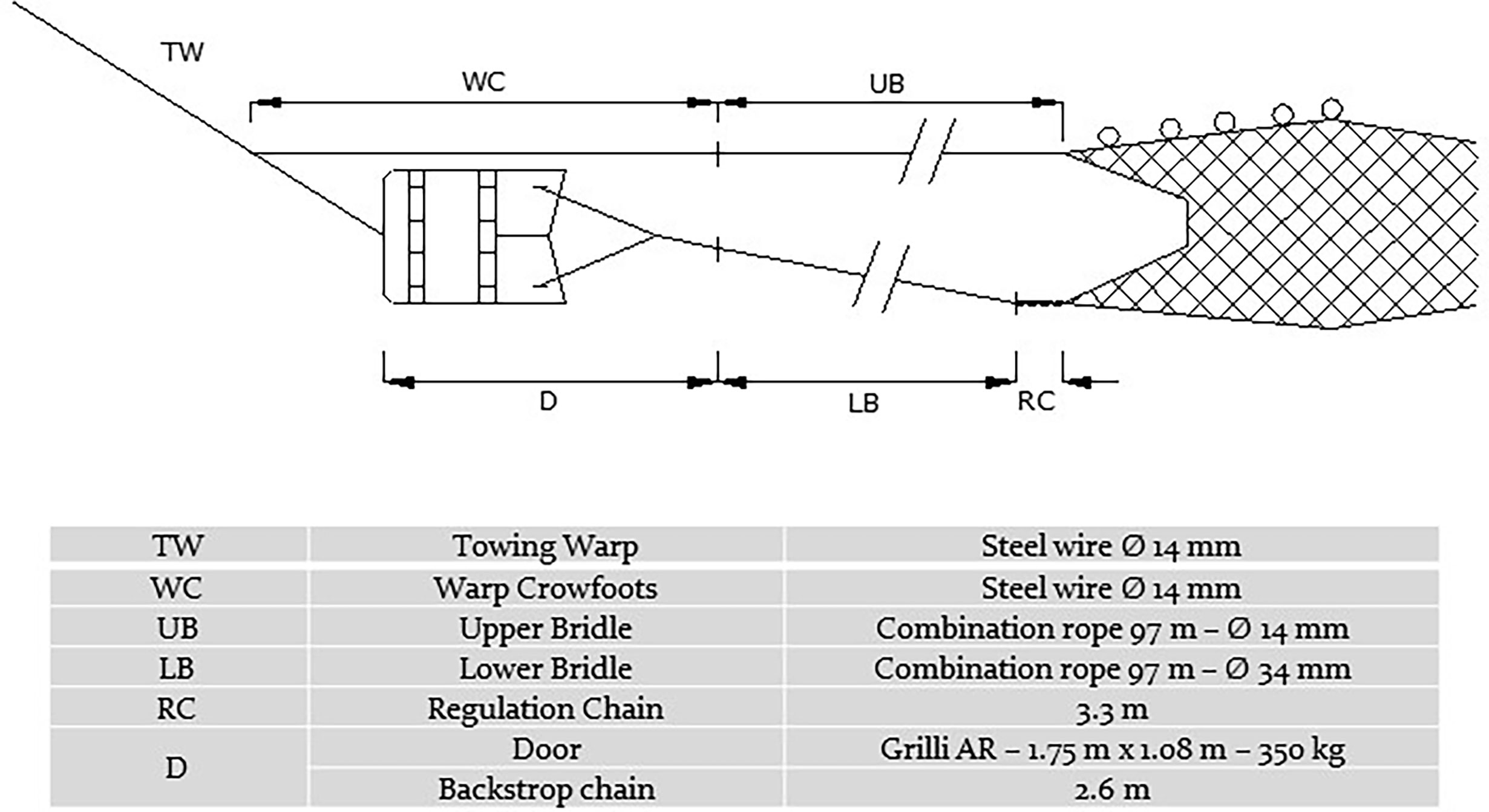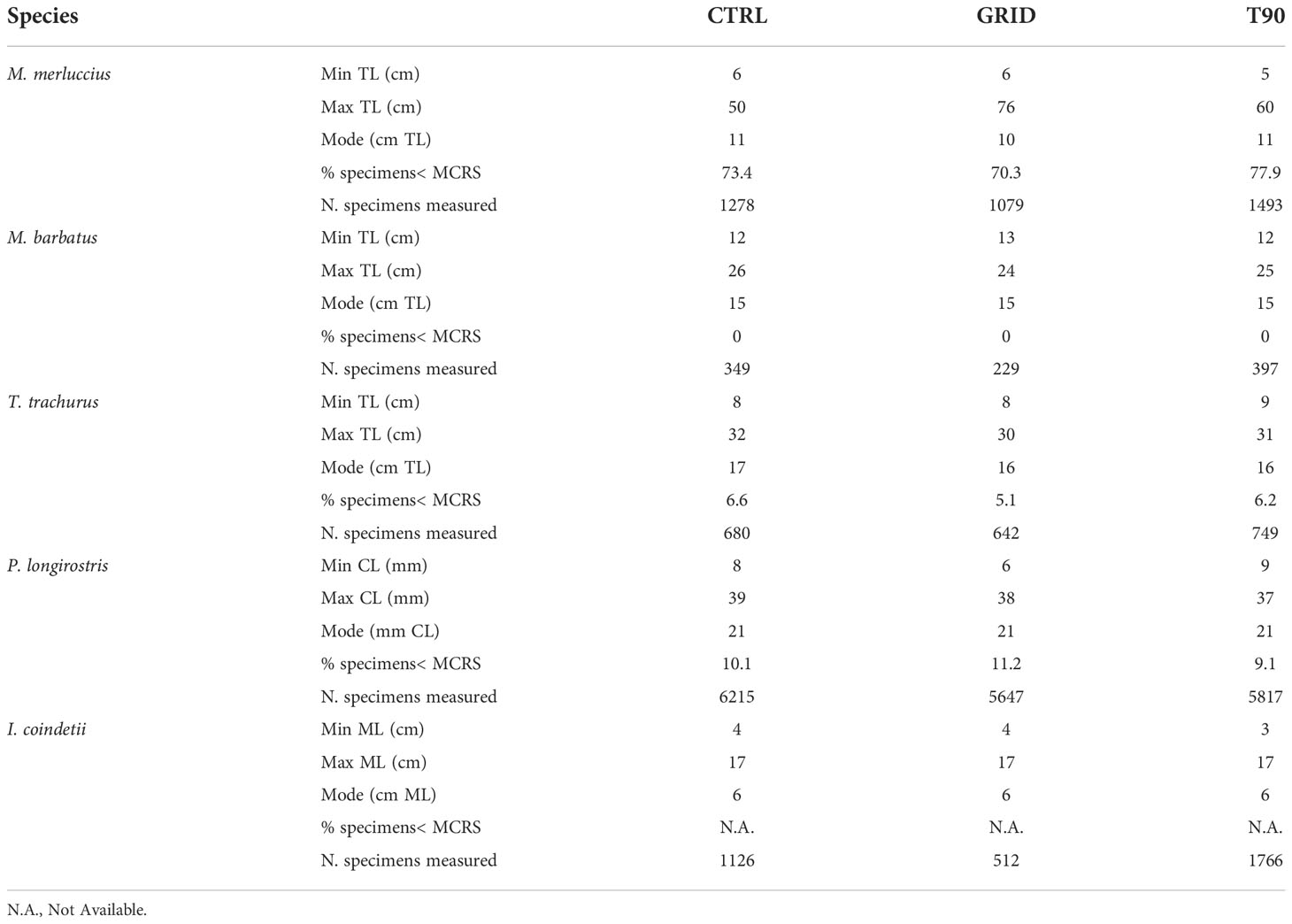- 1Consorzio per il Centro Interuniversitario di Biologia Marina ed Ecologia Applicata G. Bacci (CIBM), Livorno, Italy
- 2Aplysia - Ricerche Applicate All’ecologia e Alla Biologia Marina, Livorno, Italy
- 3Institute for Marine Biological Resources and Biotechnologies (IRBIM) - National Research Council (CNR), Ancona, Italy
In the Mediterranean, experiments and technical measures aimed at improving the selectivity of bottom trawl nets mostly concern modifications to the codend. Grids have been tested in various areas, but have not been adopted for management purposes so far. The present study aims to evaluate whether the adoption of diamond meshes turned by 90° (T90 configuration) and a selection grid with 2 cm bar spacing, both placed in the extension piece of a commercial bottom trawl net, can contribute in reducing the capture of specimens under the Minimum Conservation Reference Size (MCRS) for the main commercial species. The results indicated that the T90 configuration has no effect compared to the commercial net commonly used by fishers. The grid showed a reduction of the catches of European hake individuals between 11 and 19 cm Total Length (TL). However, the use of this device reduced the catch of many species, such as red mullet, deep-water rose shrimp and broad tail short fin squid. This reduction was observed also for specimens above MCRS. In conclusion, the T90 applied to the extension piece does not provide any improvement in selectivity, contrary to what has been observed when the T90 is placed at the codend. In contrast, the grid could be a possible way to increase selectivity. However, the use of grid should be further investigated to identify settings that can avoid the loss of a substantial fraction of commercial catch.
Introduction
The practice of discarding at sea is a major issue for many commercial fisheries. Pérez Roda et al. (2019) report that in the Mediterranean and Black Sea a biomass of at least 275,000 tonnes is discarded every year. Discarding occurs because most fishing gears and practices are not selective enough for the targeted species and sizes (Clucas, 1997). Therefore, discards are the effect of inefficient fishery exploitation patterns and may have negative consequences on the stocks, ecosystems and the marine environment (Frid et al., 2003; FAO, 2011).
Discards include both target species and any other commercial and non-commercial species, that are returned at sea dead or alive (Alverson et al., 1994). According to Tsagarakis et al. (2014), the biomass discarded by the Mediterranean fisheries can vary between 20% and 65% of the total biomass caught. This wide range is the consequence of large-scale geographic and regional differences in discarding practices, mainly due to commercial preferences, fishing strategies (gear type and target species), and environmental characteristics, such as substrate type, depth, productivity and seasonality which affects the species composition of demersal communities. Discards in the Mediterranean fisheries are also due to the presence of specimens of commercial species below the Minimum Conservation Reference Size (MCRS), a management measure in force in the EU Member States that fixes a threshold size for the landings of the most important commercial species, included in the Annex IX Part A of the Regulation (EU) 2019/1241 (EU, 2019a).
Bellido et al. (2017) reported that in the Mediterranean Sea the discards of undersized individuals of regulated species, such as European hake (Merluccius merluccius), horse mackerels (Trachurus spp.) and sparids (Sparidae), can vary from 18% to 77% of the catch of each species. Sartor et al. (2016) and Spedicato et al. (2018) reported that discards of individuals below MCRS account for 18% of the total catch of European hake, 7% of red mullet, 1% of deep-water rose shrimp, and 37% of horse mackerel in the Ligurian and northern Tyrrhenian Sea.
The European Union has tried to implement strategies to reduce discards in bottom trawling. Under the EU Common Fisheries Policy (CFP), the Art. 15 of the EC Regulation 1380/2013 (EU, 2013), known as the “Landing Obligation”, which provides for the prohibition of discarding of the regulated species, aims at streamlining the development of more selective technical solutions and fishing practices. In 2010, the minimum legal mesh size of codend of bottom trawl nets was increased from 40 mm diamond mesh to 40 mm square mesh (or 50 mm diamond mesh) following Council Regulations (EC) 1967/2006 and EU Regulation 2019/1241 (EC, 2006; EU, 2019a). The updated legal meshes still allow catching specimens under the MCRS for most of the regulated species, therefore this does not seem a fully effective measure to solve the problem of discarding (Lucchetti et al., 2021). According to the Landing Obligation, discards management should lead to disproportionate costs for fishers, which would therefore force them to adopt more selective fishing strategies (Prellezo et al., 2016).
The recent Multiannual Management Plan (MAP) launched by the European Union for the demersal resources of the western Mediterranean (EU, 2019b) is mainly focused on the recovery of the stocks of target and by-catch species exploited by bottom trawling. The Plan is based primarily on a fishing effort regime, but it foresees also measures aimed at reducing the impact of fishing mortality on juveniles (e.g., temporal closures of nursery areas). The MAP also includes the possibility to adopt technical measures to increase the selectivity of fishing gears.
In the last 15 years, a wide range of selectivity studies aiming at reducing unwanted catches in trawl fisheries have been conducted in the Mediterranean, testing diamond and square meshes of different sizes in the codend (Bahamon et al., 2006; Guijarro and Massutí, 2006; Sala et al., 2008; Sala and Lucchetti, 2011; Ordines et al., 2014; Brčicć et al., 2018; Mytilineou et al., 2021, among others), as well as modifications of the codend circumference (Özbilgin et al., 2005; Sala and Lucchetti, 2011; Sala et al., 2016; Tokaç et al., 2016), and changes in twine thickness or net material (Tokaç et al., 2004; Bahamon et al., 2006; Sala et al., 2007).
Technical solutions affecting the mesh configuration of the net can be alternative technical solutions to be tested. The 90° turned mesh configuration (T90) is a simple rotation by 90° of a traditional diamond mesh netting; as a result, the meshes remain open during towing and under the weight of the catch, enabling smaller specimens to escape (Wienbeck et al., 2011; Madsen et al., 2012). The T90 in the extension piece of the net has been recently tested in the Catalan Sea (Sola and Maynou, 2018a; Maynou et al., 2021) with promising results (e.g., the increase of modal length of the catch of European hake and red mullets), and in the Adriatic Sea (Petetta et al., 2022).
Other technical solutions aiming at reducing the unwanted catch are the by-catch reducing devices (BRDs), which are structures inserted in fishing gears with the aim of providing an escape route for unwanted species or sizes (Eayrs et al., 2007). A recent study carried out in the Strait of Sicily (Vitale et al., 2018a) showed improved selectivity of European hake and deep-water rose shrimp using juvenile and trash excluder devices (JTED) grids with spaced bars of 20 and 25 mm inserted in the extension piece of the trawl net.
The present study aims to test two selectivity devices placed in the extension piece of the commercial trawl net commonly used by fishers operating in the northern Tyrrhenian Sea (NW Mediterranean): i) a section of the net with diamond meshes rotated by 90° (T90); ii) a selection grid oriented to guide small animals to be released through an escape opening in the upper panel of the net. The effects of these two devices in improving the exploitation pattern and reducing the discard rates of the traditional trawl net were tested by means of an experimental study. The present work focuses on three important species of the WestMed MAP, European Hake, M. merluccius (HKE), deep-water rose shrimp, Parapenaeus longirostris (DPS), and red mullet, Mullus barbatus (MUT), as well as two additional commercial species, horse mackerel, which are abundant, Trachurus trachurus (HOM), and broad tail short fin squid, Illex coindetii (SQM).
Materials and methods
Data collection
The experimental trials aiming at testing the T90 mesh geometry on the extension piece and the juveniles selection grid (GRID) were conducted using a chartered trawler belonging to the Porto Santo Stefano fleet (FV Ciro I) in August 2020. Two transects of five hauls each (depth range 80-230 m) were selected in the fishing grounds exploited by the Porto Santo Stefano trawl fleet (Figure 1), where European hake and deep-water rose shrimp are the main targets. The experiment was carried out by means of the alternated hauls method (Wileman et al., 1996); hauls were conducted using the commercial trawl net (control net, CTRL) to compare catches with those obtained with the tested devices (T90 and GRID). A total of 81 experimental hauls was performed during daytime:
- 27 hauls with the control net (extension piece 44 diamond mesh (DM); codend 40 square mesh (SM));
- 27 hauls with 44 mm T90 mesh geometry in the extension piece (codend 40 SM);
- 27 hauls with the GRID in the extension piece (extension piece netting 44 DM; codend 40SM).
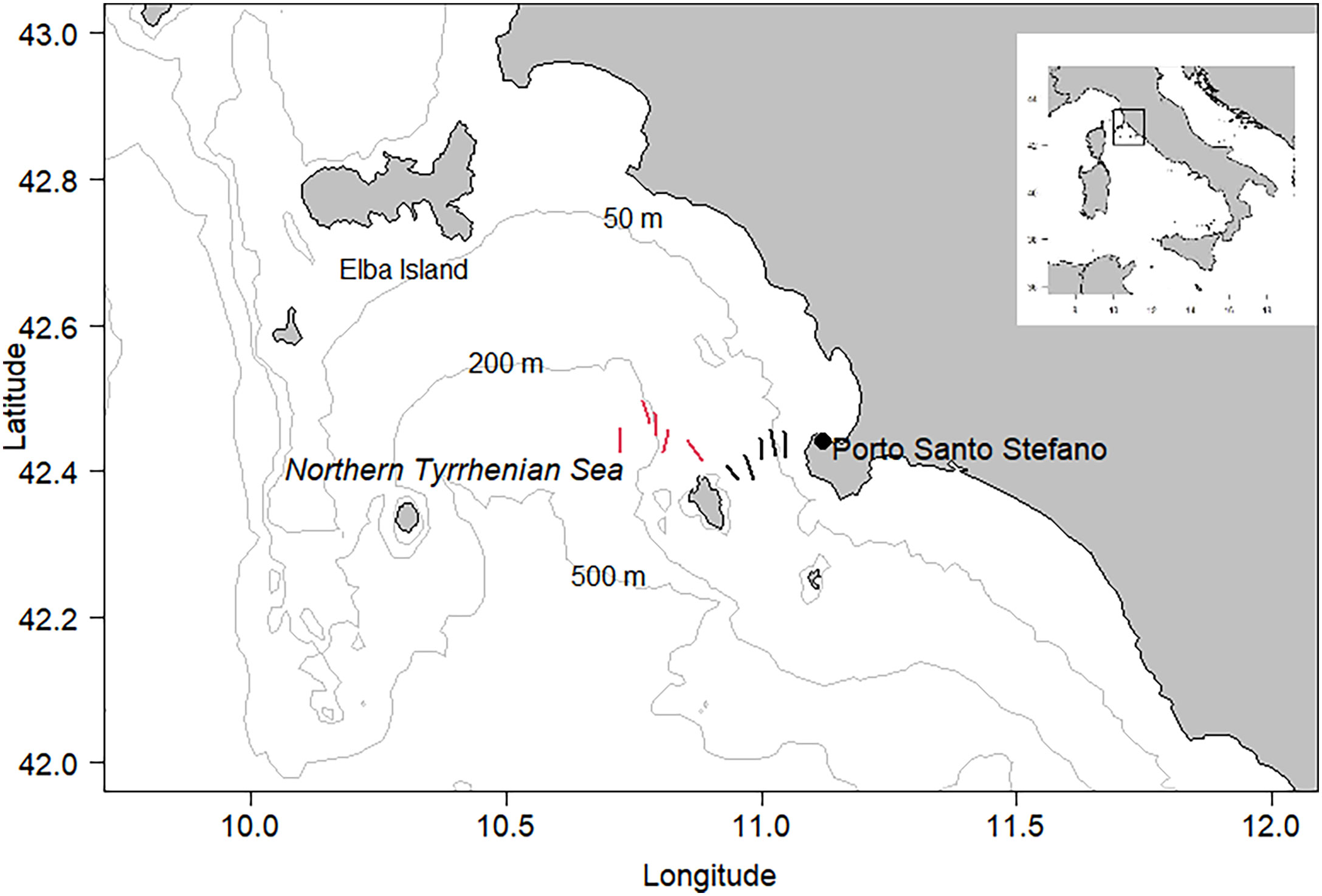
Figure 1 Northern Tyrrhenian Sea (part of the FAO-GFCM GSA9). Location of the two transects (red and black lines) selected for the implementation of the survey.
During the towing operations, the net was equipped with acoustic sensors to monitor the net geometry (vertical and wing openings). A Kruskall-Wallis H test (χ2) was applied to evaluate possible differences in vertical and wing openings among the three net configurations.
For the experiments, the vessel used a 4-faces trawl net (i.e. 4 panel trawls, with bottom, upper and side panels). The overall trawl net length was about 75 m. The scheme of the gear is summarized in Figures 2, 3. The polyethylene headrope was 43.5 m long and its diameter was 28 mm. The number of floats was 30, with a diameter of 100 mm. The footrope was 56 m long with a diameter of 34 mm; the material was a combination between polyethylene, steel braid and nylon. The extension piece had a conical shape with a length of 10 m, and with the number of meshes along the circumference ranging from 390 in the proximal part to 200 in the distal part. The mesh in the extension piece was 44 mm DM. Finally, the codend was 6 m long, and the number of meshes at circumference was 200 with a 40 mm SM.
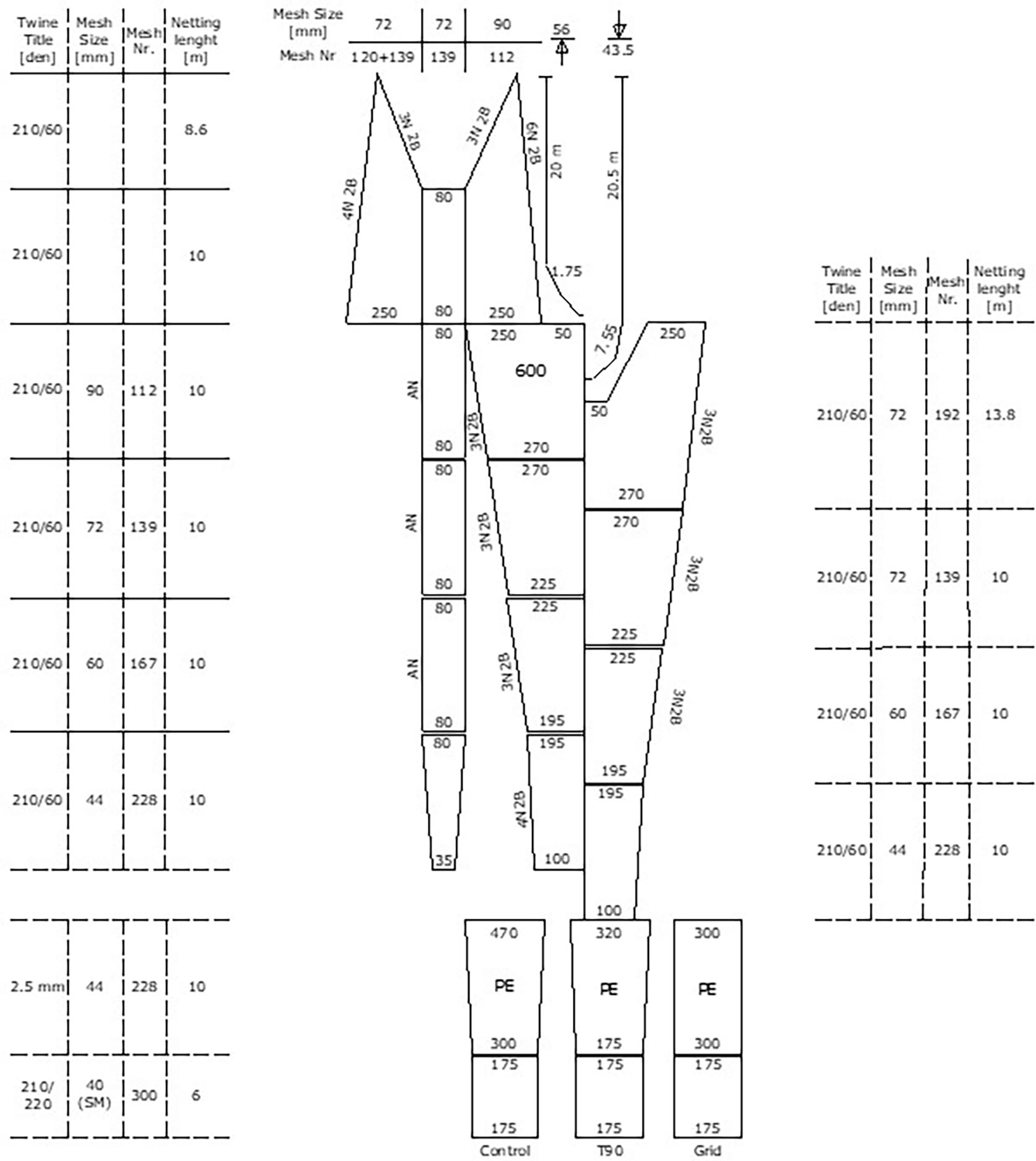
Figure 2 Scheme of the trawl nets used in the survey, with details of the extension piece of the three net configurations (Control, Grid and T90).
The 90° turned mesh configuration (T90) was built from the same netting panel used for the traditional 44 DM configuration of the commercial net. The T90 configuration was mounted along the entire length (10 m) of the extension piece of the experimental net (Figure 4).
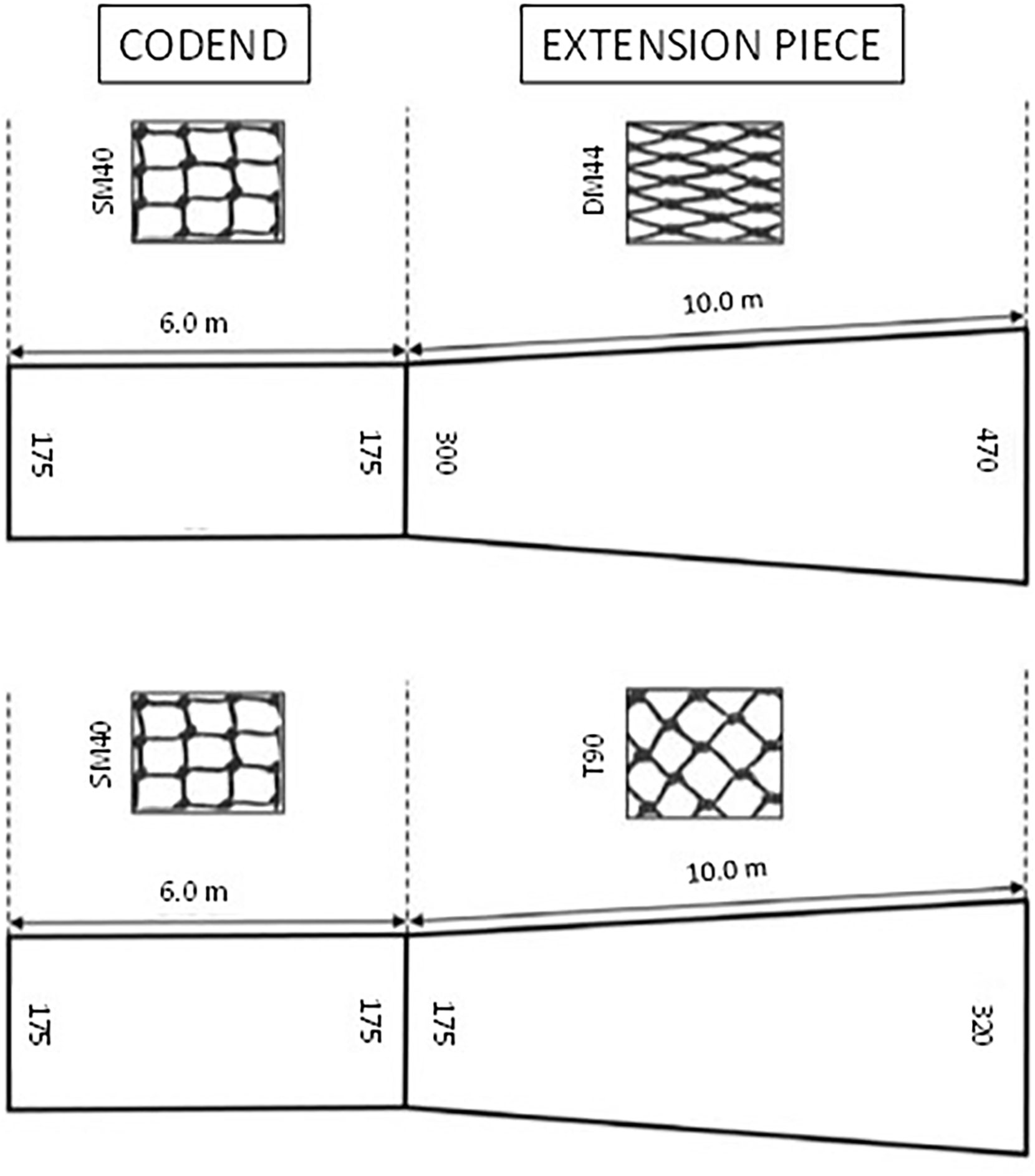
Figure 4 Scheme of the structure of cod-end and extension piece in the CTRL (above) and the T90 (below) nets (from Sola and Maynou, 2018a; modified). SM40: 40 mm square mesh. DM44: 44 mm diamond mesh.
The selection grid (GRID) developed for the sea trials was the “FLEXGRID” designed by “Ocean Marine and Fishing Gear A/S”, a company based in Denmark with high experience in developing and providing selection grids for commercial fishing. FLEXGRID is a very light grid made of an alloy of high-strength plastic material. This material ensures a remarkable elasticity and ability to withstand considerable bends and resume its natural shape when the mechanical stress is over. These features allow the grid maintaining a stiff configuration during trawling, and safely winding around a standard net winch as the net is hauled on board. The dimensions of the FLEXIGRID used for this study (Figure 5) were 110 x 85.6 cm (height x width). It had three horizontal bars (20 mm thick) spaced 25 cm each other, and 27 cm from the top to the bottom of the grid. These horizontal bars are required to maintain the rigidity of the grid during towing. The grid had 24 vertical bars (15 mm thick) spaced 20 mm each other. The lower section of the grid (approximately 25% of the total area) had a hole that guides large animals (i.e. the commercial catch) towards the codend (Figure 5, blue area). The grid was mounted on a tubular netting section (6 m in length) with a tilt angle of approximately 46˚ and placed in the extension piece, just in front of the codend. The inclination of the grid favours the contact between the vertical bars and the specimens entering the net and, therefore, the escapement of the smaller ones. An escape opening was cut in the upper part of the net, just behind the selection grid. The opening in the lower part of the grid allows the conveying of the larger fish towards the codend.
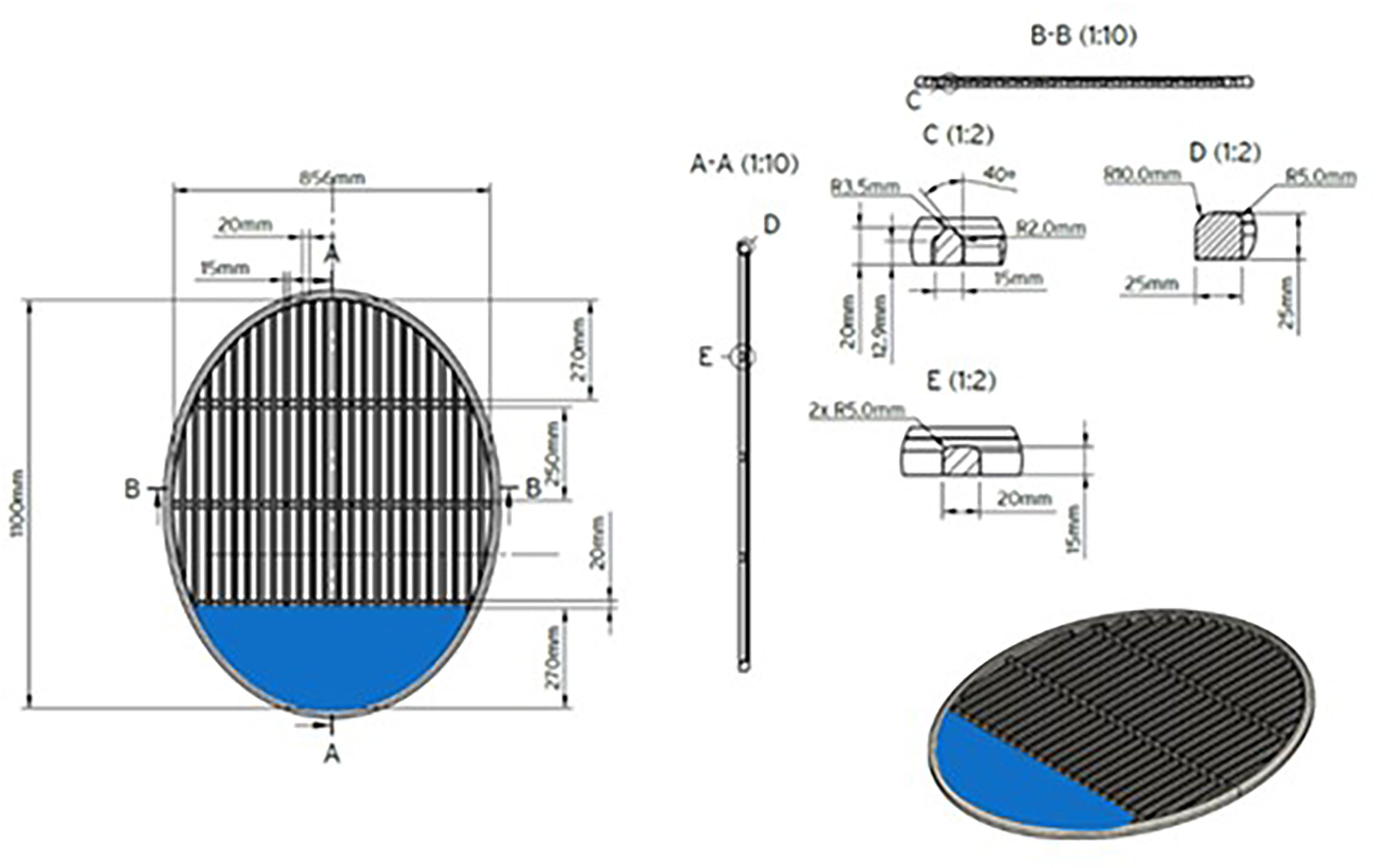
Figure 5 Scheme of the “FLEXGRID”, a juvenile selection grid employed for the sea trials. The blue area indicates the hole in the grid through which the commercial catch is diverted to the codend.
Each towing operation was performed with a duration ranging between 30 and 40 minutes, and at a speed of about 3.0 nautical miles per hour (knots). At the end of each experimental haul, once the net was opened on board, the catch was sorted by the fishing crew, and divided into commercial and discarded fractions. The commercial fraction was processed on board. The size of all commercial species (Total Length, TL, to the 0.5 cm below for bony fishes; Carapace Length, CL, to the 1 mm below for crustaceans; Mantle Length, ML, to the 0.5 cm below for cephalopods) was measured on board (sub-sampling was usually performed for deep-water rose shrimp catches, which weighed between 10 and 40 kg per haul). For each haul, discards (whole or a sub-sample) were frozen and brought to the lab for analysis. At the end of each sampling day at sea, the meshes of the net used were measured using the Omega Mesh Gauge. The GRID meshes were checked as well.
Data analysis
Catch rates in biomass (kg h-1) of target species and bycatch categories were analysed by means of Generalized Additive Model (GAM) (Hastie and Tibshirani, 1990; Zuur et al., 2009) to assess the performance of the different net types tested in the sea trials. A simple GAM with Gaussian error distribution (and identity link), and Depth and NetType as covariates was fitted to catch rate data (kg h-1) as dependent variable, according to the following model:
Depth was modelled as a smoother, while NetType was used as a 3-levels factor: CTRL, T90, and GRID. A significance level of 0.05 was used for the analysis. Model residuals were visually analysed to check for assumptions of homogeneity and normality (Zuur et al., 2009). All the analyses were performed in R (version 4.0.3) (R Core Team, 2020) with the package mgcv (Wood, 2006).
The absence of cover did not allow evaluating the absolute selectivity (i.e. estimation of a L50 and a Selection Range), because the total population that is exposed to the gears is not known. However, it was possible to estimate the relative catch performance and efficiency between the nets equipped with the selective devices (T90 and GRID) and the commercial net (CTRL). The methodology applied to evaluate the effectiveness of Test net vs a Control net (namely, a traditional commercial net) was based on the catch comparison method described by Holst and Revill (2009).
The sampling was designed to minimize the differences between control and test hauls. They were parallel each other, thus simulating a “twin net” operating in the same area, approximately with the same trawl duration and on the same fish population. In this way, the same number of controls and tests were carried out, simulating a paired sampling design. A standardization (individuals per hour) was applied to adjust for the small differences in time duration between corresponding control and test hauls, making the following analysis unbiased.
To assess the influence of the test nets (GRID or T90) on the size composition of the species caught, the polynomial regression Generalized Linear Mixed Model (GLMM, with hauls as random intercept) was used to fit curves for the expected proportions of the total catch and thus to assess the catch efficiency (at length) of test nets relative to Control net.
The probability of a fish of a determined length being retained by the Test gear follows the formula:
where and are species subsampling ratios (namely, the proportions taken out for measurements, if any, from the catch bulk) in each Test and Control h haul, k is the order of the polynomial to be tested and bh ~ N(0,σ2) is the error associated to the model. A binomial error distribution was used to calculate the probability of the number of fish caught in the Test net given they enter both gears by each size class. A probability of 0.5 (the split parameter) corresponds to equal catches in both gears. As suggested by Holst and Revill (2009), the best model was the minimal degree polynomial curve that captures the main trends indicated by the observed proportions, although in some instances a 1st or 2nd order would be enough. The best model describing the retention probability was decided based on the lowest value of AIC (Zuur et al., 2009). According to the parsimony rule, when two models showed AIC values difference less than 5 units, the best model was chosen based on the degree of freedom (the less degree of freedom, the more parsimonious model).
The models were reported with 95% confidence intervals (Efron, 1987) accounting for within- and between-hauls variation (Millar, 1993). Confidence intervals were calculated by means of a double bootstrap resampling first hauls, then resampling fish with hauls and fitting the chosen model to the resampled data. The procedure was repeated 1000 times. The analyses were performed using the selfisher R package (v. 1.0; Brooks et al., 2022).
Results
No significant differences in the trawl opening among the three net configurations were found (Kruskal–Wallis H test, χ2 = 0.386, df = 2, p > 0.05 for the wing horizontal opening; χ2 = 0.421, df = 2, p > 0.05 for the vertical opening).
During the survey, a total of 154 species or major taxa was collected, 69 bony fish, 5 elasmobranchs, 15 cephalopods, 16 decapod crustaceans and 49 other taxa. The taxonomic list with the abundance indices (biomass in kg and number of specimens per fishing hour) for the three types of net employed is shown in Table 1S in the Supplementary Material.
In general, the catches obtained in all the experimental hauls were characterised by a great number of species, most of them belonging to by catch and non-commercial fraction. The standardised yields of the total biomass caught were 56.4 kg/h, 62.5 kg/h and 49.3 kg/h for CTRL, T90 and GRID, respectively. According to the sorting of the catch made by the fishers on board, discards in biomass represented 17.5% of the total catches in CTRL, 20.2% in T90 and 23.5% in GRID; this fraction included 38.7% of the total biomass of bony fish in CTRL, 39.2% in T90 and 36.0% in GRID. For crustaceans the proportion of discard was 3.8%, 3.4% and 7.4% in CTRL, T90 and GRID, respectively. In contrast, the biomass discarded was very low for cephalopods in all the net configurations.
Among the commercial species, the five target species of this study ranked among the most abundant ones, both in numbers and weight in the three gear configurations. The largest catches in biomass were obtained for deep-water rose shrimp (12.0 kg/h in CTRL, 12.8 kg/h in T90 and 8.5 kg/h in GRID), while horse mackerel, T. trachurus, showed values of 3.2 kg/h in CTRL, 3.3 kg/h in T90 and 1.9 kg/h in GRID. European hake showed yields of 1.7 kg/h in CTRL, 1.8 kg/h in T90 and 1.5 kg/h in GRID. Broadtail shortfin squid, I. coindetii, showed notably higher catches in CTRL (2.6 kg/h) and T90 (2.4 kg/h) than in GRID (0.5 kg/h). Yields of red mullet, M. barbatus, were 1.4 kg/h in both CTRL and T90 and 0.9 kg/h in GRID. Detailed data are reported in Table 1S in the Supplementary Material.
As shown in Table 1, the catch below the Minimum Conservation Reference Size (MCRS) represented an important fraction of European hake catches, especially in terms of number of specimens (specimens below the 20 cm TL MCRS: 73.4% in CTRL, 77.9% in T90 and 70.4% in GRID); it was noticeably lower in deep-water rose shrimp (specimens< 20 mm CL: 10.1% in CTRL, 9.1% in T90 and 11.2% in GRID) and horse mackerel (specimens< 15 cm TL: 6.6% in CTRL, 6.2% in T90 and 5.1% in GRID). The percentage of specimens< 11 cm TL (MCRS) was null for red mullet in all the net configurations.
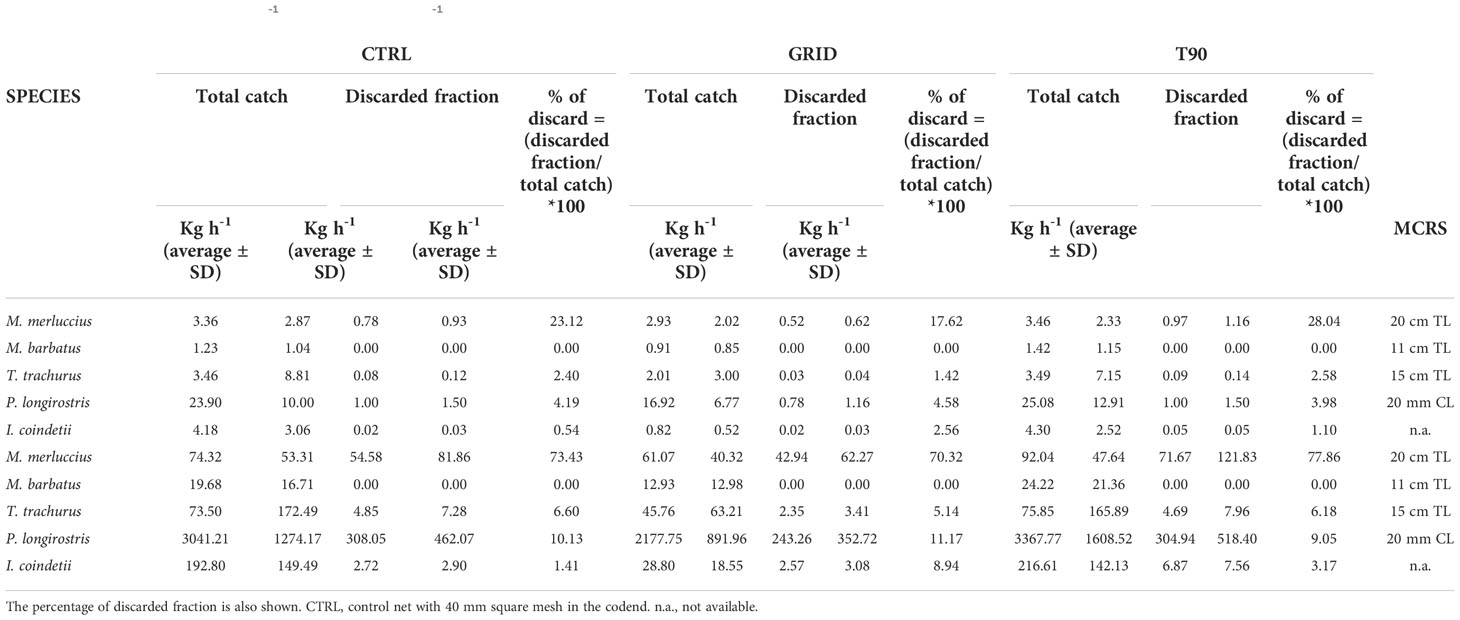
Table 1 Mean (± SD) biomass (kg h-1) and abundance (n h-1) indices of the total catch and discarded fraction of the target species.
Catch comparison - Yields
Table 2 shows the results of the GAM analyses to compare catches in biomass obtained with the three net configurations, performed on a suite of 12 combinations of categories and species (total catch; commercial fraction; discards; catches by species, above and below MCRS). Table 2 shows the outcomes for the factor NetType only. The full overview of the results of the GAM analysis (including the effect of the Depth variable, modelled as a smoother) is reported in the Supplementary Material. Figure 6 shows the violin plots for each net type made through an exploratory analysis before performing the GAM.
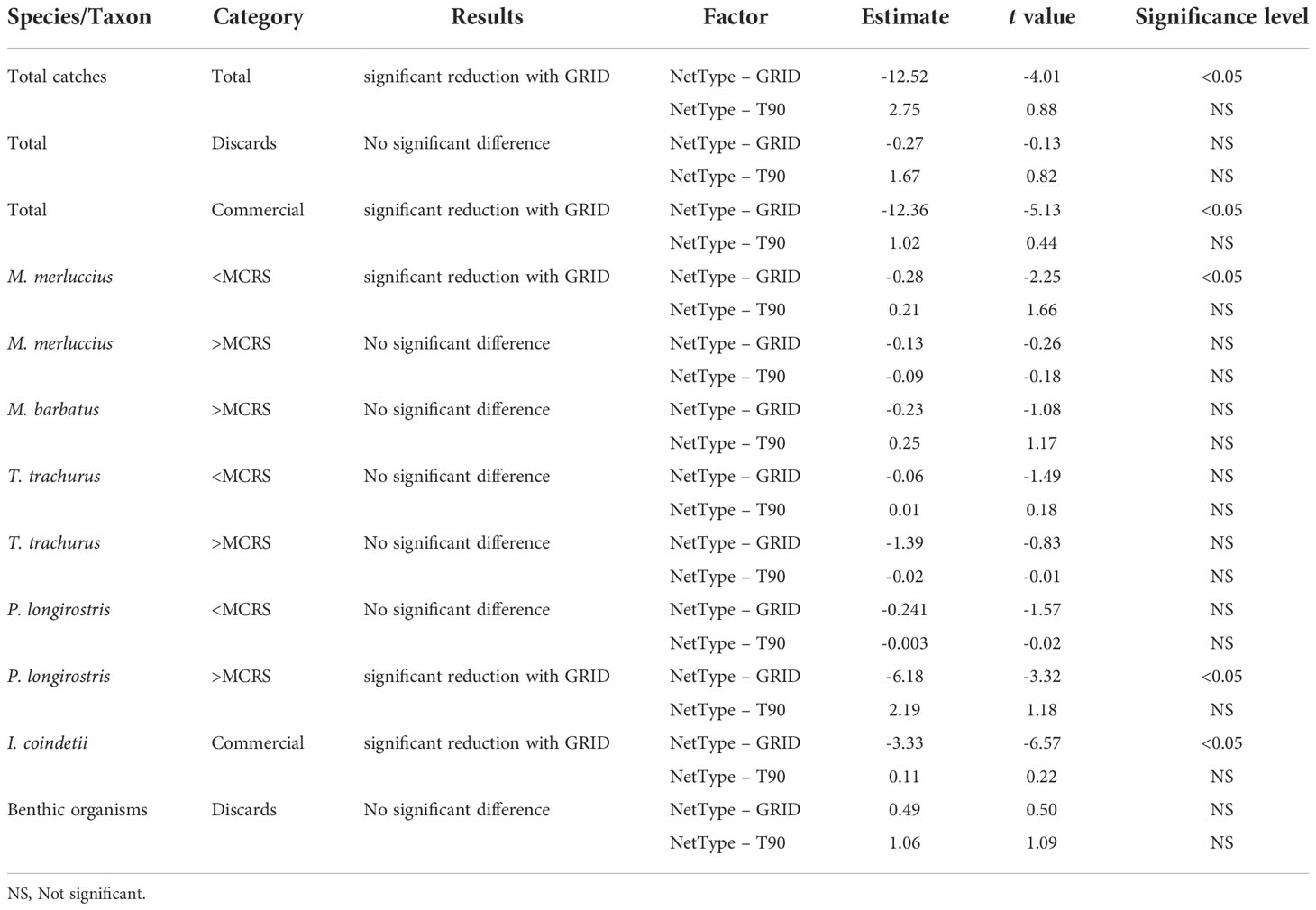
Table 2 Summary of the results of the GAM analyses performed on the catch rates (kg h-1) of a suite of 12 combinations of species/taxa and categories.
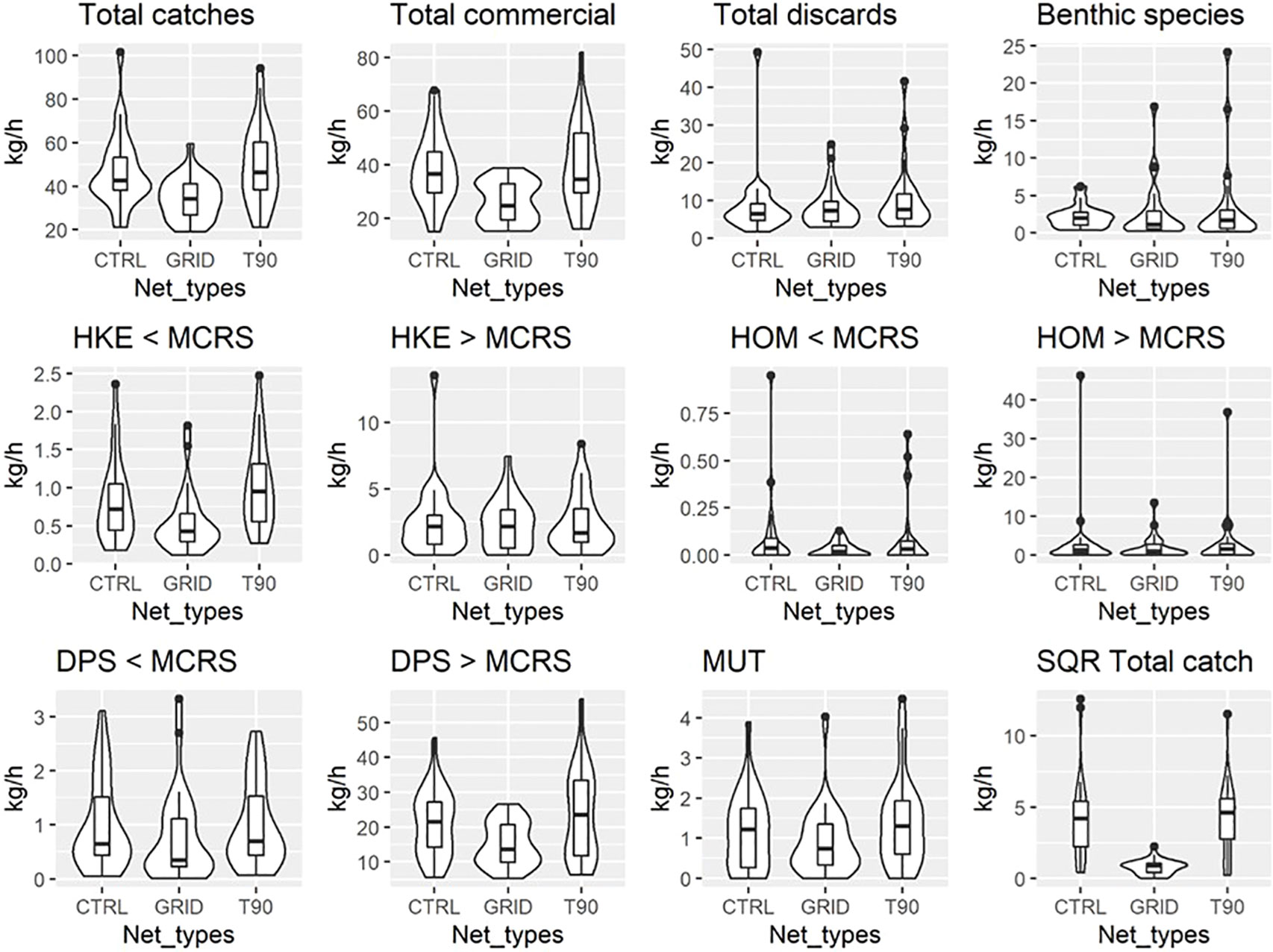
Figure 6 Violin plots in kg h-1 for the three types of net. The lower and higher lines of the boxes are the first and third quantile, respectively; the bold line is the median and the vertical lines delimit the minimum and maximum values excluding outliers. The kernel probability density of the data at different values is also shown.
As concerns total catches, a significant reduction was observed for the net equipped with the GRID compared to the CTRL, while no significant difference was observed comparing the net equipped with the T90 and the CTRL.
For the discarded fraction, the catch rates did not show significant differences among the three net configurations tested. A significant reduction in total commercial catches was observed for GRID compared to CTRL and T90, while no significant difference was observed between the latter two nets configurations.
Regarding the group of benthic organisms, that includes mainly Echinoderms, Gastropods and Cnidarians, no significant difference was found comparing the catches obtained with the three net configurations.
At species level, a significant reduction in the catch rates of undersized individuals (<MCRS, 20 cm TL) of European hake was observed for the GRID compared to the CTRL, while no significant difference was observed comparing CTRL and T90. No significant difference was observed among the three nets tested in terms of catches of individuals above the MCRS.
As regards deep-water rose shrimp, no significant difference in the catch rates of undersized individuals (MCRS, 20 mm CL) was observed among the three nets. However, a significant reduction in the catch rates of individuals above the MCRS was observed for the GRID compared to the CTRL, while no significant difference was observed comparing T90 and CTRL. For the broadtail shortfin squid, which does not have a MCRS, a significant reduction in the catch rates was observed for the GRID compared to the CTRL, while no significant difference was observed between the T90 and the CTRL. As regards horse mackerel and red mullet, no significant differences were observed in the catch rates of the three nets.
Catch comparison – Demographic structures
The comparison of the demographic structure (Figure 7; Table 3 and Table 2S in Supplementary Material) of the catches obtained with the CTRL and those with the T90 did not show any improvement in selectivity using the T90 in the extension piece.
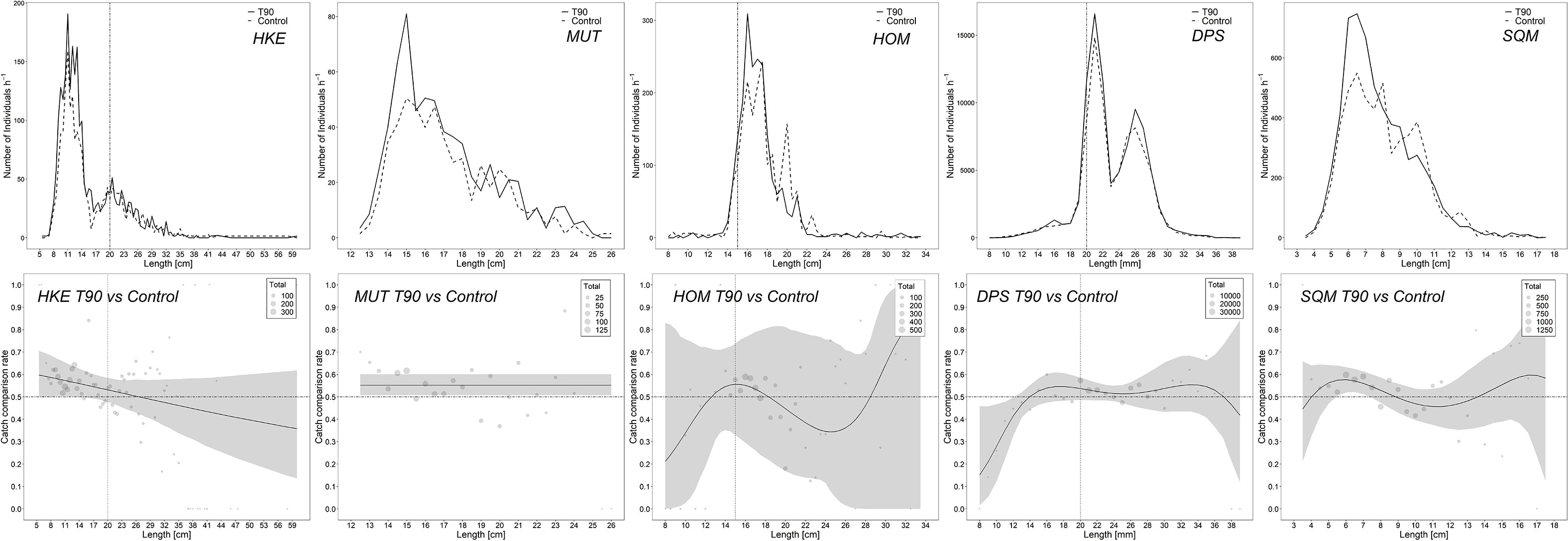
Figure 7 Length frequency distributions (above) and modelled catch comparison rates (below) of the T90 extension and the CTRL. HKE: M. merluccius; MUT: M. barbatus; HOM: T. trachurus; DPS: P. longirostris; SQM: I. coindetii. Black dotted vertical lines correspond to the MCRS of each species, if any. In the catch comparison graphs, the point-dashed horizontal line at 0.5 represents the point at which both gears have equal catch rates. The solid black line corresponds to the modelled catch comparison while the grey area is its 95% confidence interval. Dots corresponds to the individual proportions retained and the size is proportional to the total individual of each size class.
The comparison of the demographic structure of the catches between the CTRL and the GRID (Figure 8; Table 3 and Table 2S in Supplementary Material) showed improved selectivity with the GRID, which allowed reducing the catch of European hake specimens between 11 and 19 cm TL. No difference for European hake individuals above MCRS was found.
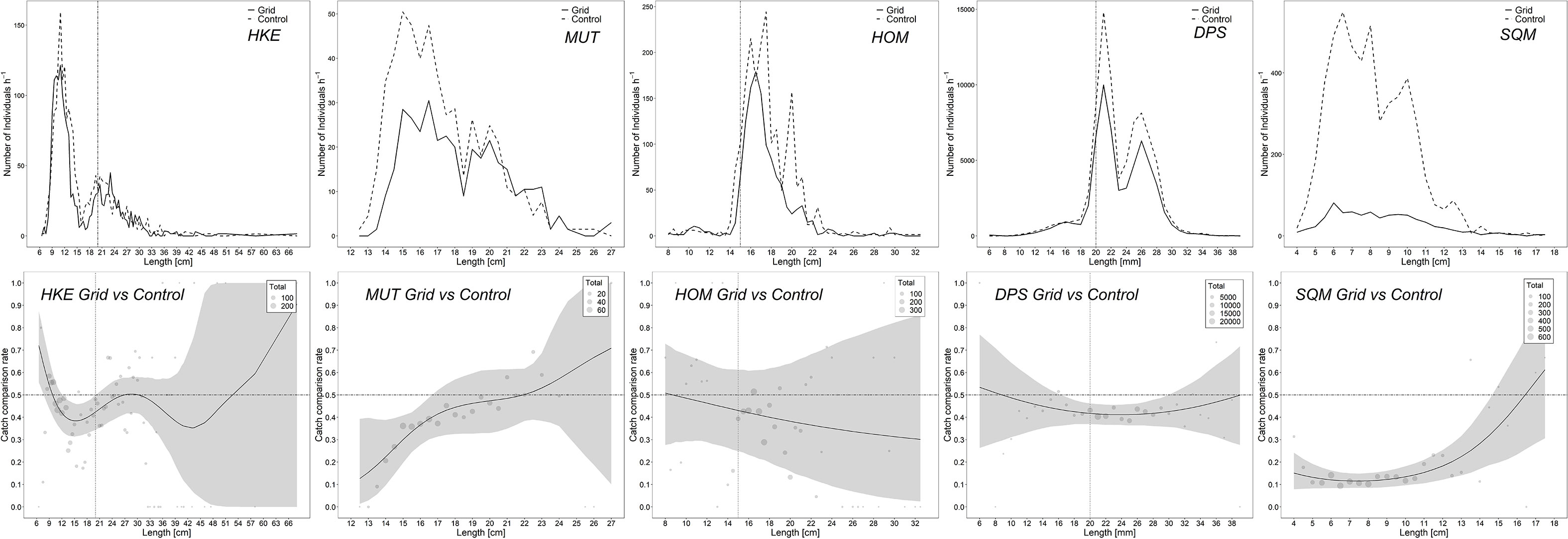
Figure 8 Length frequency distributions (above) and modelled catch comparison rates (below) of the GRID and the CTRL. HKE: M. merluccius; MUT: M. barbatus; HOM: T. trachurus; DPS: P. longirostris; SQM: I. coindetii. Black dotted vertical lines correspond to the MCRS of each species, if any. In the catch comparison graphs, the point-dashed horizontal line at 0.5 represents the point at which both gears have equal catch rates. The solid black line corresponds to the modelled catch comparison while the grey area is its 95% confidence interval. Dots corresponds to the individual proportions retained and the size is proportional to the total individual of each size class.
In most of the other investigated cases, the GRID produced important losses in the catch; this was evident for broadtail short fin squid, with a sharp decrease of all size classes in the catch.
For red mullet, the loss of catches produced by the GRID affected specimens of the commercial fraction, below 17 cm TL, as no individuals below MCRS were caught during the experiment. Also for deep-water rose shrimp, the use of this device determined a loss of specimens from 20 to 25 mm CL. As regards horse mackerel, the high dispersion of the experimental data hampered to detect differences between the size distributions of the GRID and the CTRL.
Discussion
In the Mediterranean, the presence of a large number of undersized and juvenile specimens in the trawl catches produces negative effects on the population dynamics of most commercial species. As shown by recent stock assessments, the situation in the Mediterranean is particularly critical, where 75% of the analysed stocks are overexploited (FAO, 2020).
In order to reduce fishing mortality on juveniles, different management actions aiming at increasing the size at first capture of the exploited stocks have been proposed and implemented in EU Mediterranean waters, such as spatio-temporal closures and technical measures, as well as a general reduction of fishing effort.
Several technical measures have been tested with the aim of increasing the trawl net selectivity by means of changes in the mesh size of the codend. The adoption of 40 mm square or 50 mm diamond meshes enforced with the Mediterranean regulation (EC, 2006) still not sufficient to improve the stocks status, as for many species it does not ensure a length at first catch larger than their MCRS (Bahamon et al., 2006; Tokaç et al., 2010; Sala et al., 2015 among others). In recent years, several experiments have been testing the T90 configuration applied to the codend, and they have shown some improvement in selectivity compared to the codend with diamond mesh configuration (Tokaç et al., 2014; Deval et al., 2016).
The adoption of the T90 configuration does not present technical difficulties and is almost inexpensive, therefore it could be easily adopted by fishers and managers. This is a not negligible aspect given that fishers are always reluctant to implement changes that imply losses of catch volume and values in the short term, though benefits are expected in the long-term (Bahamon et al., 2007).
Recently, some experiments have been carried out in the Mediterranean to evaluate whether the T90 configuration can lead to a significant increase in selectivity if applied to different sections of the trawl net, other than the codend. Sola and Maynou (2018a) and Maynou et al. (2021) in the Catalan Sea, and Petetta et al. (2022) in the Adriatic Sea experimented trawl nets with the T90 configuration placed in the extension piece, i.e. the section of the net just in front of the codend. The results obtained by those experiments are contrasting. In the case of Sola and Maynou (2018a) and Maynou et al. (2021), the T90 placed in the extension piece determined an increase in the size at first catch of European hake, well above the MCRS, as well as an increase in the catch rates of this species. For red mullet and striped red mullet, the legal mesh size of codend (40 mm square or 50 mm diamond) already allows catching individuals larger than the MCRS and the use of the T90 in the extension piece would mainly result in a commercial catch reduction. Petetta et al. (2022) tested both a reduction in the number of meshes in the extension piece, a modification that reduces the net diameter, and the T90 placed in the same section of the net. In this case, although the number of meshes was lower, the T90 arrangement did not cause a reduction in the diameter of the experimental net compared to that of the commercial one. The main findings by Petetta et al. (2022) revealed that the T90 configuration performed differently based on the different target species. For the European hake, no substantial difference was found between the control and the T90 nets, also considering the catch of individuals below MCRS (20 cm TL). Therefore, the size selectivity was not improved for this species using the net with T90 configuration in the extension piece. Concerning red mullet, the T90 net proved to be the most size selective net, but this was associated to a significant loss of individuals above MCRS.
Similarly to what was reported by Petetta et al. (2022), the comparative analysis that we did between the size structure of the control net and that of the net equipped with the T90 did not show any significant improvement in selectivity. Therefore, the hypothesis suggested by Petetta et al. (2022) and formulated by other authors (Grimaldo et al., 2007; He et al., 2008; Winger et al., 2010) seems to be supported also by our results. According to these authors, a common behaviour of many fish species is to stay away from the meshes when they enter a relatively narrow section of the net such as the extension piece. Likely, fish, in particular the small sized ones, continue to swim in the direction of towing without attempting to escape until they get tired and are dragged into the codend where the interaction with the meshes of the net and the eventual escape take place. Although these hypotheses need to be validated by direct observations, e.g. from underwater cameras, our results confirm that the extension piece does not significantly contribute to increasing the selectivity process of the net, which occurs essentially at the level of the codend, especially during hauling operations (Madsen et al., 2012).
The differences between our findings and those by Sola and Maynou (2018a) and Maynou et al. (2021) in the Catalan Sea for the T90 net configuration could be related to the characteristics of the nets used in the two different areas. In the Catalan Sea, the net was equipped with a codend considerably shorter than the one used in the present study (1.4 m vs 6.0 m). The use of a very short codend, whose length is further reduced by the binding closure applied at the bottom of the codend, could facilitate its quick filling and consequently the interaction between the fish and the terminal part of the extension piece. In fact, the experiment performed by Maynou et al. (2021) showed an increase in selectivity in the case of T90 meshes placed in the rear part of the extension piece, in close contact with the codend, while in the case of the T90 meshes placed in a frontal position in the extension piece, at a distance of 8.0 m from the codend, no significant variation in selectivity with respect to the control net was observed.
Selection grids aimed at reducing bycatch of undersized individuals have been tested in some areas of the Mediterranean (Sardà et al., 2005; Massuti et al., 2009; Özvarol, 2016). Although this device was proposed in the early 1980s to reduce the capture of large sized animals, such as sea turtles (Epperly, 2003; Lucchetti et al., 2016; Lucchetti et al., 2019; Vasapollo et al., 2019), experiments have shown that grids can be used to reduce the catch of juveniles, without affecting the catch of large sized fish (Aydın et al., 2011; Aydın and Tosunoğlu, 2011). Therefore, according to the characteristics of the fishery and the target species, different typologies of grids can be used.
Previous experiments showed that the installation of selection grids can increase the selectivity for European hake up to 19 cm TL (Sardà et al., 2004; Sardá et al., 2006; Bahamon et al., 2007; Massutí et al., 2009). Sardá et al. (2006), testing grids in a continental shelf mixed fishery in the Catalan Sea, reported that selection grids of 15 and 20 mm bar spacing resulted less size selective than the 36 mm square mesh codend, at least for the main target species of the fishery (European hake, red mullet, horse mackerel). In contrast, the selectivity of 20 mm selection grid substantially improved the selection length of European hake, poor cod (Trisopterus capelanus), greater forkbeard (Phycis blennoides) and Norway lobster (Nephrops norvegicus), when compared against the selectivity of 40 mm diamond mesh (Bahamon et al., 2007).
In the present study, the comparison of the size structure of the catch retained by the control net and the net equipped with the selection grid did show some improvement in selectivity.
The net equipped with the grid was effective in reducing the catch of European hake specimens between 11 and 19 cm TL. However, the grid also showed significantly lower catch rates of individuals greater than MCRS, as in the case of red mullet and deep-water rose shrimp, the main target species on the fishing grounds exploited by the local trawl fleet. Moreover, a significant loss in catches of other species, such as broadtail shortfin squid, another target species for the local trawl fleet, was observed in the net equipped with the grid. These results agree with those by Vitale et al. (2018a), who tested different types of grids in the Strait of Sicily, including a grid with 20 mm bar spacing similar to the one experimented in the present work.
The selection grids operate in a similar way to the codend meshes. Differently to the T90 in the extension piece, where the selection occurs only if the fish try to escape by actively swimming towards the meshes of the net, in the case of the grid the contact between the fish and the gear occurs almost passively. Thus, the use of the grid placed in the extension piece may be an alternative option to the increase of mesh size. The studies by Brčicć et al. (2015) and Lucchetti et al. (2016) have shown that the specimens that escape through the selection grid seem to have a greater survival rate than those selected at the level of the codend. However, information on the survival rate of the specimens escaped from the selectivity devices is currently scarce and scattered in the Mediterranean. At present, there is no information on the survival of deep-water rose shrimp and European hake selected through the grid. This is an important aspect to be taken into account when evaluating the performance of any device aimed at increasing the selectivity of the catch.
Another important aspect for a proper assessment of the performance of the grids is the effect of the debris or the abundant catches in the net that can obstruct the grid itself (Suuronen and Sardà, 2007). To this end, experiments replicating the “commercial conditions” of the nets should be performed; for example, the duration of the usual commercial hauls is notably longer (e.g. up to 3 of 4 hours) than that of the experimental ones. This aspect can strongly affect the net filling, especially on fishing grounds where the presence of discards (e.g. invertebrates) is abundant.
The adoption of gears modified to increase selectivity can find their application if they are easy to use, does not substantially increase the costs of building and maintaining fishing gears, and does not imply economical losses. Fishers are always reluctant to increase the selectivity of the gear, as this always determines, at least in the short-medium term, a loss in commercial yields. This reluctance could be overcome by providing, at least in the initial stages of adopting changes to the gears, compensation measures that can mitigate the effects of economic losses. Bio-economic forecasting models applied to simulate the use of more selective fishing gears have shown that the initial economic loss could be in many cases largely recovered in the medium and long term (Prellezo et al., 2017; Sola and Maynou, 2018b; Vitale et al., 2018b).
In conclusion, the studies of the selectivity of trawl nets in the Mediterranean mainly concerned the cod-end. Only recently, experiments have been carried out modifying the meshes in other parts of the net, e.g. the T90 configuration in the extension piece. The few experiments conducted so far have shown contradictory results, and the need to continue investigating to obtain more robust knowledge. Also in the case of selection grids to avoid the capture of small specimens there are aspects to be explored more deeply, such as the operation of this device in commercial fishing conditions and the survival of the escaped specimens to evaluate whether the grids can be a valid alternative to codend selectivity.
The results of our study showed that the T90 mesh configuration placed in the extension piece does not produce a positive effect on the selectivity of the bottom trawl net, at least for the nets used in the northern Tyrrhenian Sea, which are characterized by large dimensions (length and diameter) and long codend. The grid seems to be a better solution to reduce the catch of specimens below the MCRS, although in the present study the reduction of unwanted catches was usually associated with some loss in the commercial fraction. Therefore, there is the need for further investigations to better understand the technical feasibility of such a device when working in commercial conditions (e.g., 3-4 hours towing), and evaluate its economic viability taking into consideration the observed loss of commercial catches.
Data availability statement
The raw data supporting the conclusions of this article will be made available by the authors, without undue reservation.
Ethics statement
Ethical review and approval was not required for the animal study because The research is authorised by the European Union and the Italian Ministry of Agriculture.
Author contributions
All authors contributed to the article and approved the submitted version.
Funding
This study was conducted in the framework of the IMPLEMED project: “Improving the selectivity of trawl gears in the Mediterranean Sea to advance the sustainable exploitation pattern of trawl fisheries” (Tender EASME/EMFF/2016/032), under a contract with CINEA (former EASME) financed by the European Union budget. The opinions expressed in the paper are those of the authors only and do not represent the contracting authority’s official position.
Acknowledgments
We are grateful to the skipper Armando Costaglione for his advice, assistance, and the crew of the FV CIRO I for the on-board rigging of the tested devices tested during the trials.
Conflict of interest
The authors declare that the research was conducted in the absence of any commercial or financial relationships that could be construed as a potential conflict of interest.
Publisher’s note
All claims expressed in this article are solely those of the authors and do not necessarily represent those of their affiliated organizations, or those of the publisher, the editors and the reviewers. Any product that may be evaluated in this article, or claim that may be made by its manufacturer, is not guaranteed or endorsed by the publisher.
Supplementary material
The Supplementary Material for this article can be found online at: https://www.frontiersin.org/articles/10.3389/fmars.2022.1017766/full#supplementary-material
References
Alverson D. L., Freeberg M. H., Murawski S. A., Pope J. G. (1994). A global assessment of fisheries bycatch and discards (Rome: FAO), 233.
Aydın C., Tokaç A., Aydın I., Erdogan U., Maktay B. (2011). Species selectivity in the eastern Mediterranean demersal trawl fishery using grids to reduce non target species. J. Appl. Ichthyol. 27, 61–66. doi: 10.1111/j.1439-0426.2010.01605.x
Aydın C., Tosunoğlu Z. (2011). Evaluation of sorting grids for deep water rose shrimp (Parapenaeus longirostris) in the Eastern Mediterranean demersal trawl fishery. J. Appl. Ichthyol. 28, 102–106. doi: 10.1111/j.1439-0426.2011.01897.x
Bahamon N., Sardà F., Suuronen P. (2006). Improvement of trawl selectivity in the NW Mediterranean demersal fishery by using a 40 mm square mesh codend. Fish. Res. 81, 15–25. doi: 10.1016/j.fishres.2006.05.020
Bahamon N., Sardà F., Suuronen P. (2007). Potential benefits from improved selectivity in the northwest Mediterranean multispecies trawl fishery. ICES. J. Mar. Sci. 64, 757–760. doi: 10.1093/icesjms/fsm052
Bellido J. M., García-Rodríguez M., García-Jiménez T., González-Aguilar M., Carbonell-Quetglas A. (2017). Could the obligation to land undersized individuals increase the black market for juveniles: evidence from the Mediterranean? Fish. Fish. 18, 185–194. doi: 10.1111/faf.12166
Brčicć J., Herrmann B., Sala A. (2015). Can a square-mesh panel inserted in front of the codend improve the exploitation pattern in Mediterranean bottom trawl fisheries? Fish. Res. 183, 13–18. doi: 10.1016/j.fishres.2016.05.007
Brčicć J., Herrmann B., Sala A. (2018). Predictive models for codend size selectivity for four commercially important species in the Mediterranean bottom trawl fishery in spring and summer. effects of codend type and catch size. PloS One 13 (10), e0206044. doi: 10.1371/journal.pone.0206044
Brooks M. E., Melli V., Savina E., Santos J., Millar R., O’Neill F. G., et al. (2022). Introducing selfisher: open source software for statistical analyses of fishing gear selectivity. Can. J. Fish. Aquat. Sci. 9, 1–9. doi: 10.1139/cjfas-2021-0099
Clucas I. (1997). A study of the options for utilization of bycatch and dis-cards from marine capture fisheries (Rome: FAO), 59.
Deval M. C., Özgen G., Özbilgin H. (2016). Selectivity of 50-mm T0 and T90 cod ends for commercial shrimp species in the Turkish deepwater trawl fishery, eastern Mediterranean. J. Appl. Ichthyol. 32, 1041–1057. doi: 10.1111/jai.13128
Eayrs S., Hai N. P., Ley J. (2007). Assessment of a juvenile and trash excluder device in a Vietnamese shrimp trawl fishery. ICES. J. Mar. Sci. 64, 1598–1602. doi: 10.1093/icesjms/fsm123
EC (2006). Council regulation no 1967/2006 of 21 December 2006, concerning management measures for the sustainable exploitation of fishery resources in the Mediterranean Sea, amending regulation (EEC) no 2847/93 and repealing regulation (EC) no 1626/94. Off. J. Eur. Union. 75, 9–64.
Efron B. (1987). Better bootstrap confidence intervals. J. Am. Stat. Assoc. 82, 171–185. doi: 10.1080/01621459.1987.10478410
Epperly S. P. (2003). “Fisheries-related mortality and turtle excluder devices (TEDs),” in The biology of Sea turtles. CRC marine science series. Eds. Lutz P. L., Musick J. A. (Boca Raton, Florida: CRC Press, Inc.), 339–353.
EU (2013). Regulation (EU) 1380/2013 on the common fisheries policy, amending council regulations (EC) no 1954/2003 and (EC) no 1224/2009 and repealing council regulations (EC) no 2371/2002 and (EC) no 639/2004 and council decision 2004/585/Ec. Off. J. Eur. Union. 354, 22–61.
EU (2019a). Regulation (EU) 2019/1241 of the European parliament and of the council of 20 June 2019 on the conservation of fisheries resources and the protection of marine ecosystems through technical measures. Off. J. Eur. Union. 97, 105–201.
EU (2019b). Regulation (EU) 2019/1022 of the European parliament and of the council of 20 June 2019 establishing a multiannual plan for the fisheries exploiting demersal stocks in the western Mediterranean Sea and amending regulation (EU) no 508/2014. Off. J. Eur. Union 172, 1–17.
FAO (2011). International guidelines on bycatch management and reduction of discards (Rome: Food and Agricultural Organization of the United Nations).
FAO (2020). The state of Mediterranean and black Sea fisheries 2020 (Rome: General Commission for the Mediterranean). doi: 10.4060/cb2429en
Frid C., Law R., Pawlak J. F., Hammer C., Loeng H., Reid P. C., et al. (2003). Environmental status of the European seas (Copenhagen: ICES), 75.
Grimaldo E., Larsen R. B., Holst R. (2007). Exit windows as an alternative selective system for the barents Sea demersal fishery for cod and haddock. Fish. Res. 85, 295–305. doi: 10.1016/j.fishres.2007.03.005
Guijarro B., Massutí E. (2006). Selectivity of diamond- and squaremesh codends in the deepwater crustacean trawl fishery off the Balearic islands western Mediterranean. ICES. J. Mar. Sci. 63, 52–67. doi: 10.1016/j.icesjms.2005.08.011
Hastie T. J., Tibshirani R. J. (1990). Generalized additive models. monogr. stat. appl. probability, 43 (Boca Raton: Chapman & Hall), 335.
He P., Smith T., Bouchard C. (2008). Fish behaviour and species separation for the gulf of Maine multispecies trawls. J. Ocean. Technol. 3, 59–77.
Holst R., Revill A. (2009). A simple statistical method for catch comparison studies. Fish. Res. 95, 254–259. doi: 10.1016/j.fishres.2008.09.027
Lucchetti A., Bargione G., Petetta A., Vasapollo C., Virgili M. (2019). Reducing sea turtle bycatch in the Mediterranean mixed demersal fisheries. Front. Mar. Sci. 6, 387. doi: 10.3389/fmars.2019.00387
Lucchetti A., Punzo E., Virgili M. (2016). Flexible turtle excluder device (TED): an effective tool for Mediterranean coastal multispecies bottom trawl fisheries. Aquat. Living. Resour. 29, 201. doi: 10.1051/alr/2016016
Lucchetti A., Virgili M., Vasapollo C., Petetta A., Bargione G., Li Veli D., et al. (2021). An overview of bottom trawl selectivity in the Mediterranean Sea. Mediterr. Mar. Sci. 22, 566–585. doi: 10.12681/mms.26969
Madsen N., Herrmann B., Frandsen R. P., Krag L. A. (2012). Comparing selectivity of a standard and turned mesh T90 codend during towing and haul-back. Aquat. Living. Resour. 25, 231–240. doi: 10.1051/alr/2012021
Massutí B. E., Ordines F., Guijarro B. (2009). Efficiency of flexible sorting grids to improve size selectivity of the bottom trawl in the Balearic islands (western Mediterranean), with comparison to a change in mesh cod-end geometry. J. Appl. Ichthyol. 25, 153–161. doi: 10.1111/j.1439-0426.2009.01225.x
Maynou F., Garcıía-de-Vinuesa A. G., Martıínez-Baños P., Saínchez P., Demestre M. (2021). Relative catch performance of two gear modifications used to reduce bycatch of undersized fish and shrimp in Mediterranean bottom trawl fisheries. Mar. Coast. Fish. 13, 518–533. doi: 10.1002/mcf2.10178
Millar R. (1993). Incorporation of between-haul variation using bootstrapping and nonparametric estimation of selection curves. Fish. Bull. 91, 564–572.
Mytilineou C., Hermann B., Sala A., Mantopoulou-Palouka D., Megalofonou P. (2021). Estimating overall size-selection pattern in the bottom trawl fishery for four economically important fish species in the Mediterranean Sea. Ocean. Coast. Manage. 209, 105653. doi: 10.1016/j.ocecoaman.2021.105653
Ordines F., Farriols M. T., Lleonart J., Guijarro B., Quetglas A., Massutí E. (2014). Biology and population dynamics of by-catch fish species of the bottom trawl fishery in the western Mediterranean. Mediter. Mar. Sci. 15, 613–625. doi: 10.12681/mms.812
Özbilgin H., Tosunoglu Z., Aydın C., Kaykaç H., Tokaç A. (2005). Selectivity of standard, narrow and square mesh panel trawl codends for hake (Merluccius merluccius) and poor cod (Trisopterus minutus capelanus). Turkish. J. Vet. Anim. Sci. 29, 967–973.
Özvarol Y. (2016). Size selectivity of sorting grid for eight fish species in the gulf of antalya, north eastern Mediterranean Sea. Iran. J. Ichthyol. 3, 294–303. doi: 10.22034/iji.v3i4.182
Pérez Roda M. A., Gilman E., Huntington T., Kennelly S. J., Suuronen P., Chaloupka M., et al. (2019). A third assessment of global marine fisheries discards. FAO fisheries and aquaculture technical paper no. 633 (Rome: FAO), 78.
Petetta A., Herrmann B., Virgili M., Li Veli D., Brinkhof J., Lucchetti A. (2022). Effect of extension piece design on catch patterns in a Mediterranean bottom trawl fishery. Front. Mar. Sci. 9. doi: 10.3389/fmars.2022.876569
Prellezo R., Carmona I., Garcıa D. (2016). The bad, the good, and the very good of the landing obligation implementation in the bay of Biscay: a case study of Basque trawlers. Fish. Res. 181, 172–185. doi: 10.1016/j.fishres.2016.04.016
Prellezo R., Carmona I., Garcıa D., Arregi L., Ruiz J., Onandia I. (2017). Bioeconomic assessment of a change in fishing gear selectivity: the case of a single-species fleet affected by the landing obligation. Sci. Mar. 81, 371–380. doi: 10.3989/scimar.04597.18A
R Core Team (2020). R: A language and environment for statistical computing (Vienna, Austria: R Foundation for Statistical Computing).
Sala A., Herrmann B., De Carlo F., Lucchetti A., Brčić J. (2016). Effect of codend circumference on the size selection of square-mesh codends in trawl fisheries. PloS One 11 (7), e0160354. doi: 10.1371/journal.pone.0160354
Sala A., Lucchetti A. (2011). Effect of mesh size and codend circumference on selectivity in the Mediterranean demersal trawl fisheries. Fish. Res. 110, 252–258. doi: 10.1016/j.fishres.2011.04.012
Sala A., Lucchetti A., Buglioni G. (2007). The influence of twine thickness on the size selectivity of polyamide codends in a Mediterranean bottom trawl. Fish. Res. 83, 192–203. doi: 10.1016/j.fishres.2006.09.013
Sala A., Lucchetti A., Perdichizzi A., Herrmann B., Rinelli P. (2015). Is square-mesh better selective than larger mesh? a perspective on the management for Mediterranean trawl fisheries. Fish. Res. 161, 182–190. doi: 10.1016/j.fishres.2014.07.011
Sala A., Lucchetti A., Piccinetti C., Ferretti M. (2008). Size selection by diamond- and square-mesh codends in multi-species Mediterranean demersal trawl fisheries. Fish. Res. 93, 8–21. doi: 10.1016/j.fishres.2008.02.003
Sardá F., Bahamon N., Molí B. (2006). The use of a square mesh codend and sorting grids to reduce catches of young fish and improve sustainability in a multispecies bottom trawl fishery in the Mediterranean. Sci. Mar. 70 (3), 347–353. doi: 10.3989/scimar.2006.70n3347
Sardà F., Bahamón N., Sardà-Palomera F., Molí B. (2005). Commercial testing of a sorting grid to reduce catches of juvenile hake (Merluccius merluccius) in the western Mediterranean demersal trawl fishery. Aquat. Living. Resour. 18, 87–91. doi: 10.1051/alr:2005010
Sardà F., Molí B., Palomera I. (2004). Preservation of juvenile hake (Merluccius merluccius, l.) in the western Mediterranean demersal trawl fishery by using sorting grids. Sci. Mar. 68, 435–444. doi: 10.3989/scimar.2004.68n3435
Sartor P., Carbonara P., Luchetti A., Sabatella E. C. (2016). Indagine conoscitiva sullo scarto della pesca alle specie demersali nei mari italiani Vol. 1 (Quaderni Nisea: Valutazioni propedeutiche per l’implementazione delle disposizioni comunitarie in tema di obbligo di sbarco), 40. ISBN 978-88-94-1553-1-0
Sola I., Maynou F. (2018a). Assessment of the relative catch performance of hake, red mullet and striped red mullet in a modified trawl extension with T90 netting. Sci. Mar. 82, 19–26. doi: 10.3989/scimar.04711.04A
Sola I., Maynou F. (2018b). Bioeconomic analysis of the effects of modifying the trawl extension piece with T90 netting. Sci. Mar. 82 (S1), 27–37.
Spedicato M. T., Bitetto I., Lembo G., Sartor P., Accadia P. (2018). Research for PECH committee – discard ban, landing obligation and MSY in the Western Mediterranean Sea, the Italian case (Brussels: European Parliament, Policy Department for Structural and Cohesion Policies), 80. PE 629.178. IP/B/PECH/IC/2018-068. SBN 978-92-846-4123-9. doi: 10.2861/911114 | QA-04-18-922-EN-N
Suuronen P., Sardà F. (2007). “By-catch reduction techniques in European fisheries: traditional methods and potential innovations,” in By-catch reduction in the world’s fisheries. Ed. Kennelly S. J. (Dordrecht: Springer), 37–74. doi: 10.1007/978-1-4020-6078-6_3
Tokaç A., Herrmann B., Aydin C., Kaykaç H., Ünlüler A., Gökçe G. (2014). Predictive models and comparison of the selectivity of standard (T0) and turned mesh (T90) codends for three species in the eastern Mediterranean. Fish. Res. 150, 76–88. doi: 10.1016/j.fishres.2013.10.015
Tokaç A., Herrmann B., Gökçe G., Krag L. A., Nezhad D. S., Lök A., et al. (2016). Understanding the size selectivity of red mullet (Mullus barbatus) in Mediterranean trawl codends: A study based on fish morphology. Fish. Res. 174, 81–93. doi: 10.1016/j.fishres.2015.09.002
Tokaç A., Özbilgin H., Kaykaç H. (2010). Selectivity of conventional and alternative codend design for five fish species in the Aegean Sea. J. Appl. Ichthyol. 26, 403–409. doi: 10.1111/j.1439-0426.2009.01379.x
Tokaç A., Özbilgin H., Tosunoglu Z. (2004). Effect of PA and PE material on codend selectivity in Turkish bottom trawl. Fish. Res. 67, 317–327. doi: 10.1016/j.fishres.2003.10.001
Tsagarakis K., Palialexis A., Vassilopoulou V. (2014). Mediterranean Fishery discards: Review of the existing knowledge. ICES. J. Mar. Sci. 71, 1219–1234. doi: 10.4135/9781412953924.n678
Vasapollo C., Virgili M., Petetta A., Bargione G., Sala A., Lucchetti A. (2019). Bottom trawl catch comparison in the Mediterranean Sea: Flexible turtle excluder device (TED) vs traditional gear. PloS One 14, e0216023. doi: 10.1371/journal.pone.0216023
Vitale S., Enea M., Milisenda G., Gancitano V., Geraci M. L., Falsone F., et al. (2018b). Modelling the effects of more selective trawl nets on the productivity of European hake (Merluccius merluccius) and deepwater rose shrimp (Parapenaeus longirostris) stocks in the strait of Sicily. Sci. Mar. 82 (S1), 199–208. doi: 10.3989/scimar.04752.03A
Vitale S., Milisenda G., Gristina M., Baiata P., Bonanomi S., Colloca F., et al. (2018a). Towards more selective Mediterranean trawl fisheries: are juveniles and trash excluder devices effective tools for reducing undersized catches? Sci. Mar. 82, 215–223. doi: 10.3989/scimar.04751.28A
Wienbeck H., Herrmann B., Moderhak W., Stepputtis D. (2011). Effect of netting direction and number of meshes around on size selection in the codend for Baltic cod gadus morhua. Fish. Res. 109, 80–88. doi: 10.1016/j.fishres.2011.01.019
Wileman D., Ferro R. S. T., Fonteyne R., Millar R. B. (1996). Manual of methods of measuring the selectivity of towed fishing gear. ICES. Coop. Res. Rep. 215, 126. doi: 10.17895/ices.pub.4628
Winger P. D., Eayrs S., Glass C. W. (2010). “Fish behavior near bottom trawls,” in Behavior of marine fishes: Capture processes and conservation challenges (Oxford, UK: Wiley-Blackwell), 65–103. doi: 10.1002/9780813810966.ch4
Keywords: demersal bottom trawling, selectivity, extension piece, selection grid, T90 mesh configuration, Mediterraenan sea
Citation: Sbrana M, De Carlo F, Ligas A, Massaro A, Musumeci C, Rossetti I, Sartini M, Vasapollo C, Viva C, Sartor P and Pretti C (2022) Testing experimental devices in the extension piece to increase the selectivity of bottom trawl in the Nw Mediterranean. Front. Mar. Sci. 9:1017766. doi: 10.3389/fmars.2022.1017766
Received: 12 August 2022; Accepted: 25 November 2022;
Published: 21 December 2022.
Edited by:
Valentina Melli, Technical University of Denmark, DenmarkReviewed by:
Chryssi Mytilineou, Hellenic Centre for Marine Research (HCMR), GreeceGökhan Gökçe, Cukurova University, Turkey
Copyright © 2022 Sbrana, De Carlo, Ligas, Massaro, Musumeci, Rossetti, Sartini, Vasapollo, Viva, Sartor and Pretti. This is an open-access article distributed under the terms of the Creative Commons Attribution License (CC BY). The use, distribution or reproduction in other forums is permitted, provided the original author(s) and the copyright owner(s) are credited and that the original publication in this journal is cited, in accordance with accepted academic practice. No use, distribution or reproduction is permitted which does not comply with these terms.
*Correspondence: Mario Sbrana, c2JyYW5hQGNpYm0uaXQ=
 Mario Sbrana
Mario Sbrana Francesco De Carlo2
Francesco De Carlo2 Alessandro Ligas
Alessandro Ligas Andrea Massaro
Andrea Massaro Claudia Musumeci
Claudia Musumeci Claudio Vasapollo
Claudio Vasapollo